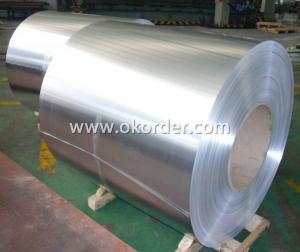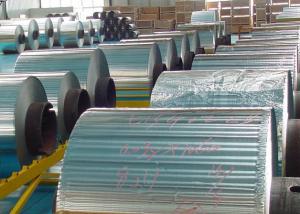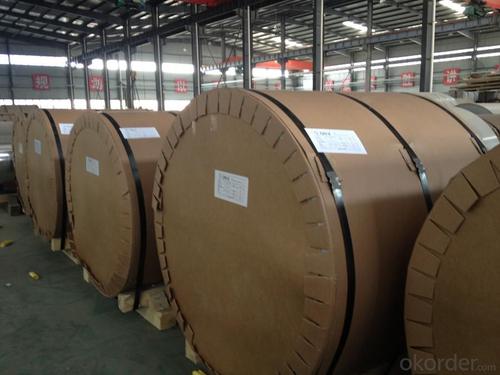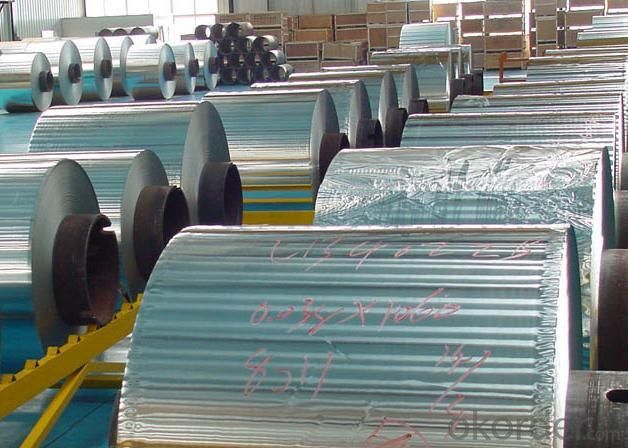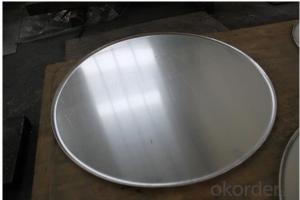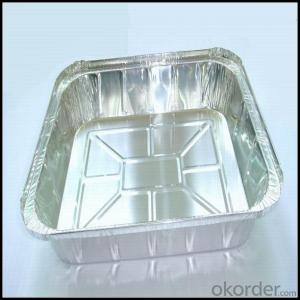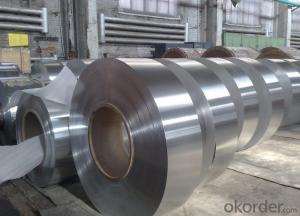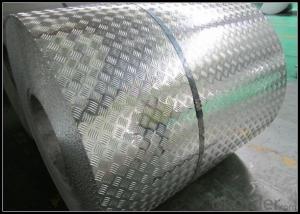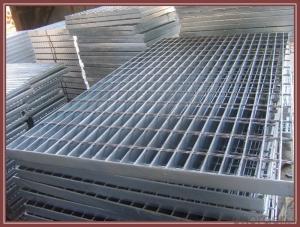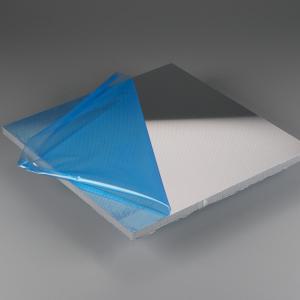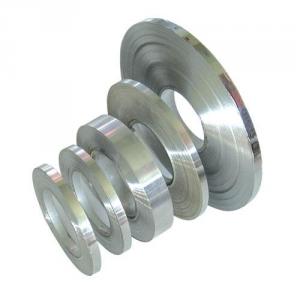8011 Painted Aluminum Trailer Sheets
- Loading Port:
- China Main Port
- Payment Terms:
- TT or L/C
- Min Order Qty:
- 3 Tons m.t.
- Supply Capability:
- 10000 Tons Per Month m.t./month
OKorder Service Pledge
OKorder Financial Service
You Might Also Like
1. Specifications of 8011 Aluminium Coils
|
Alloy |
AA8011 |
|
Temper: |
H12, H14, H16, H18, H22, H24, H26, H32,HO, F |
|
Thickness: |
0.10-500mm |
|
Width: |
10mm- 2200mm |
|
Standard: |
GB/T3880-2006, ASTM, ISO, EU standard |
|
Special Specification is available on customer’s requirement | |
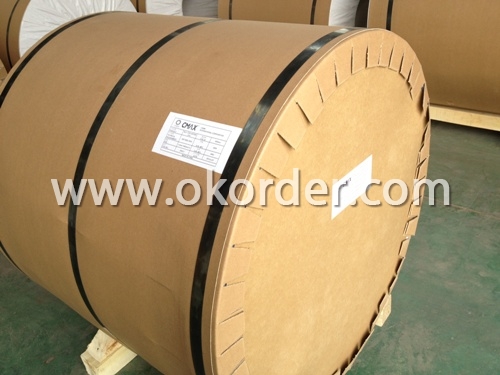
2. Applications of 8011 Aluminium Coils
8011 Aluminium Coils are widely used in househould field, package, cookware, construction, decoration, etc.
3. Package & Delivery of 8011 Aluminium Coils
Seaworthy package, water-proof paper wrapped inside, carton wrapped outside in wooden pallets by 20FCL or 40GP.

4. Production Flow of 8011 Aluminium Coils
The main producingprocedure includes the following steps:
Rolling--Annealing--Slitting--Sawing, Cut-To-Length, Shearing
- Q: Can aluminum sheet be used for food contact applications?
- Indeed, aluminum sheet is suitable for food contact applications. The food industry extensively utilizes aluminum owing to its exceptional characteristics. It is non-toxic, resistant to corrosion, and possesses a high thermal conductivity, rendering it appropriate for an array of food processing and packaging purposes. By utilizing aluminum sheets, one can craft food containers, trays, and foils, thereby offering a secure and sanitary solution for storing and transporting food. Moreover, aluminum is recyclable, making it an environmentally conscious selection for food contact applications.
- Q: Are 101 aluminum sheets suitable for decorative purposes?
- Yes, 101 aluminum sheets are suitable for decorative purposes. They offer a sleek and modern look, are lightweight, and can be easily customized or shaped to create various decorative elements.
- Q: Are aluminum sheets suitable for roofing?
- Yes, aluminum sheets are suitable for roofing. Aluminum is a popular material for roofing because it is lightweight, durable, and resistant to corrosion. It is also non-combustible, making it a safer option for roofing. Aluminum sheets are easy to install and maintain, and they can withstand harsh weather conditions such as heavy rain, snow, and wind. Additionally, aluminum is a sustainable material, as it is 100% recyclable, making it an environmentally friendly choice for roofing. Overall, aluminum sheets provide a long-lasting and reliable roofing solution for both residential and commercial buildings.
- Q: How does the thickness tolerance of aluminum sheet affect its usability?
- The thickness tolerance of aluminum sheet plays a significant role in determining its usability. The thickness tolerance refers to the acceptable deviation from the specified thickness of the sheet. It is typically expressed as a range or a plus/minus value. A tighter thickness tolerance ensures that the aluminum sheet meets the desired specifications consistently. This is crucial for applications where precise dimensions are required, such as in aerospace, automotive, and construction industries. In these applications, even a slight deviation in thickness can negatively impact the performance and functionality of the product. For instance, in aircraft manufacturing, the thickness tolerance of aluminum sheets used for structural components is highly critical. A thin sheet might compromise the structural integrity, while a thicker sheet could lead to excess weight, affecting fuel efficiency. Similarly, in the automotive industry, precise thickness tolerance is essential for ensuring compatibility and fitment of various components. On the other hand, a looser thickness tolerance can be acceptable for applications where precise dimensions are not as critical. For example, in general fabrication, signage, or decorative purposes, a wider thickness tolerance may not significantly affect the usability or appearance of the aluminum sheet. Additionally, the cost of manufacturing aluminum sheets with tighter thickness tolerances is typically higher due to increased precision and quality control measures. Therefore, the required level of tolerance should be balanced with the intended use and cost considerations. In conclusion, the thickness tolerance of aluminum sheet directly affects its usability, particularly in industries requiring precise dimensions. It is essential to select the appropriate tolerance level to ensure the sheet meets the required specifications, maintaining the desired performance and functionality of the final product.
- Q: If Aluminum can, in fact, not be sterilized I would love to know why.
- Aluminum can be sterilized. A variety of methods exist for sterilizing any material, including (but certainly not limited to) food, medical devices such as needles/syringes, and surgical metals. Here are two ways you can sterilize aluminum: Autoclave it. Autoclaving is a process where you heat an item up to approximately 300 degrees F, under high pressure. The combination of the pressure and the heat kills anything that's alive, rendering it sterile. Almost every lab in the country has at least one autoclave machine and most labware manufacturers today build their products keeping in mind that the product will be autoclaved (perhaps many dozens of times) in the future. Gamma radiation. Gamma radiation sources, such as Cobalt-60, are used to sterilize almost every item you can think of that is individually packaged in a hospital or laboratory, including test tubes, general labware, and any other liquid-handling instruments. Some foods are also sterilized this way to increase shelf life (don't worry, the food never holds any of the radiation). Aluminum can not only be sterilized, but it can be sterilized using techniques and protocols very common today. Hope this helps.
- Q: How do you ensure the flatness of large aluminum sheets?
- To ensure the flatness of large aluminum sheets, there are several key steps that can be taken: 1. Material selection: Start by choosing high-quality aluminum sheets that are specifically manufactured for flatness. These sheets should have consistent thickness and minimal internal stress to minimize the chances of warping. 2. Proper storage: Store the aluminum sheets in a controlled environment to avoid exposure to extreme temperature fluctuations or humidity. This will help prevent any potential expansion or contraction of the metal, which can lead to warping. 3. Handling and transportation: When moving or transporting the aluminum sheets, ensure that they are supported evenly to prevent any bending or flexing. Use appropriate lifting and handling equipment to avoid excessive strain on the sheets. 4. Machining and processing: During the machining and processing steps, it is crucial to use proper techniques and equipment to maintain flatness. Employ precision machinery that is capable of handling large sheets and has features to minimize distortion or bending during cutting, drilling, or forming processes. 5. Heat treatment: If necessary, heat treatment can be employed to relieve any residual stress in the aluminum sheets. Thermal stress relief techniques, such as annealing, can help reduce internal stress and improve flatness. 6. Quality control: Implement a rigorous quality control process to ensure the flatness of the aluminum sheets. This can include regular inspections using precision measuring instruments, such as straightedges or laser scanners, to detect any deviations from flatness. If any issues are identified, corrective actions can be taken promptly. By following these steps, manufacturers can ensure the flatness of large aluminum sheets, which is crucial for various industries such as aerospace, automotive, construction, and manufacturing.
- Q: Can aluminum sheets be used for structural purposes?
- Indeed, structural purposes can be fulfilled by utilizing aluminum sheets. This material, known for its lightness and remarkable malleability, can be effortlessly shaped and sized in diverse forms. Thanks to its exceptional strength-to-weight ratio, it is an ideal choice for structural applications that prioritize weight reduction. In industries such as aerospace, automotive, and construction, aluminum sheets are commonly employed to create structural components like panels, beams, and frames. Moreover, the corrosion resistance of aluminum adds to its suitability for structural purposes, particularly in outdoor or marine settings. Ultimately, aluminum sheets present a dependable and economical solution for structural applications.
- Q: Hello,Does it matter what kind of wheel I use as a cut off wheel on an angle grinder when cutting aluminum?Thanks!
- you can use the standard metal cut-of wheels as a last resort...but the low melting point of aluminium and granularity of lower grades of alu mean that you disc will clog up, so it doesn't cut efficiently, and you will get a messy cut with a lot of slag around the cut which then needs a lot of filing to tidy up. Special cut off wheels for cutting aluminium are available. You can cut alu with a circular saw as its nor harder than say oak... but again because of the low melting point you need a saw blade designed for cutting aluminum. Finally cutting aluminium with a circular saw requires that you use the right amount of force, to hard and you'll get a rought cut or stall the motor, too soft and you cover the blade in melted alu.
- Q: Is it possible to install aluminum sheets on an existing roof structure?
- <p>Yes, aluminum sheets can be installed on existing roofs. This process typically involves removing the old roofing material and ensuring the roof structure is sound. Aluminum sheets are lightweight, durable, and resistant to corrosion, making them a popular choice for roof installations. They can be installed over a solid substrate, such as plywood or metal decking, and often require a proper underlayment to ensure watertightness. It's important to follow manufacturer guidelines and local building codes when installing aluminum sheets on an existing roof. Professional installation is recommended to ensure the roof's integrity and longevity.</p>
- Q: Are aluminum sheets suitable for decorative lighting fixtures?
- Yes, aluminum sheets are highly suitable for decorative lighting fixtures. Aluminum is a lightweight and versatile material that is easy to work with and manipulate into various shapes and designs. It offers excellent corrosion resistance, making it suitable for both indoor and outdoor lighting fixtures. Additionally, aluminum can be easily coated or painted to achieve different finishes, allowing for endless design possibilities. Its reflective properties also contribute to enhancing the overall lighting effect, making it an ideal choice for decorative lighting fixtures.
1. Manufacturer Overview
| Location | Henan,China |
| Year Established | 2002 |
| Annual Output Value | Above US$200 Million |
| Main Markets | Mid East;Eastern Europe;North America |
| Company Certifications | ISO 9001:2000;ISO 14001:2004;OHSAS 18001 |
2. Manufacturer Certificates
| a) Certification Name | |
| Range | |
| Reference | |
| Validity Period |
3. Manufacturer Capability
| a) Trade Capacity | |
| Nearest Port | Shanghai |
| Export Percentage | 30%-50% |
| No.of Employees in Trade Department | 21-50 People |
| Language Spoken: | English;Chinese |
| b) Factory Information | |
| Factory Size: | Above 100,000 square meters |
| No. of Production Lines | Above 10 |
| Contract Manufacturing | OEM Service Offered;Design Service Offered |
| Product Price Range | Average |
Send your message to us
8011 Painted Aluminum Trailer Sheets
- Loading Port:
- China Main Port
- Payment Terms:
- TT or L/C
- Min Order Qty:
- 3 Tons m.t.
- Supply Capability:
- 10000 Tons Per Month m.t./month
OKorder Service Pledge
OKorder Financial Service
Similar products
Hot products
Hot Searches
Related keywords

